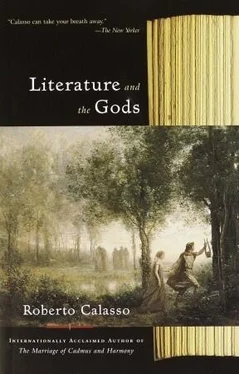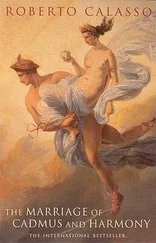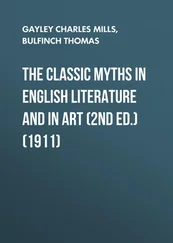Baudelaire’s article on the école païenne is unique in that in just a few pages of what disguises itself as lively journalism he manages to bring together three elements that had never previously been thought of as inextricably connected: the reawakening of the gods, parody, and what I will be calling “absolute literature,” by which I mean literature at its most piercing, its most intolerant of any social trappings. Now let’s turn from that to the scenario as it presents itself today. First and most obviously, the gods are still among us. But they are no longer made up of just the one family, however complicated, residing in their vast homes on the slopes of a single mountain. No, now they are multitudes, a teeming crowd in an endless metropolis. It hardly matters that their names are often exotic and unpronounceable, like the names one reads on the doorbells of families of immigrants. The power of their stories is still at work. Yet there is something new and unusual about the situation: this composite tribe of gods now lives only in its stories and scattered idols. The way of cult and ritual is barred, either because there is no longer a group of devotees who carry out the ritual gestures, or because even when someone does perform these gestures they stop short. The statues of Śiva and Vi  u still drip with offerings, but
u still drip with offerings, but  is a remote and shapeless entity to the Indian of today, while Prajāpati is only to be found in books. And this, one might say, has become the natural condition of the gods: to appear in books — and often in books that few will ever open. Is this the prelude to extinction? Only to the superficial observer. For in the meantime all the powers of the cult of the gods have migrated into a single, immobile and solitary act: that of reading. In the delirium of their love affair with the microchip, people insist on asking tedious questions about the survival of the printed word. While the truly extraordinary phenomenon that is everywhere before us is never even mentioned: the vertiginous and unprecedented concentration of power that has gathered and is gathering in the pure act of reading. That we may be gazing at a screen rather than a page, that the numbers, formulas, and words appear on liquid crystal rather than paper, changes nothing at all: it is still reading. The theatre of the mind seems to have expanded to include rank upon teeming rank of patient signs, all incorporated in this prosthesis which is the computer. Meanwhile, with superstitious confidence, all the sorcery and powers at play are attributed to what appears on the screen, not to the mind that elaborates it — and above all reads . Yet what could be more technologically advanced than a transformation that takes place in a totally invisible way, within the mind? The development is dense with hidden consequences. By uniting with the screen the mind, trained or untrained, creates a new kind of Centaur, grows used to seeing itself as an unlimited theatre. Boundless as it is, this apparently new scene resembles nothing more than the vibrant oceanic expanse that the Vedic seers thought of as the mind itself, manas . And already in the interstices of that great theatre vast caverns are opening up before our eyes, whence as ever echo the names of the gods.
is a remote and shapeless entity to the Indian of today, while Prajāpati is only to be found in books. And this, one might say, has become the natural condition of the gods: to appear in books — and often in books that few will ever open. Is this the prelude to extinction? Only to the superficial observer. For in the meantime all the powers of the cult of the gods have migrated into a single, immobile and solitary act: that of reading. In the delirium of their love affair with the microchip, people insist on asking tedious questions about the survival of the printed word. While the truly extraordinary phenomenon that is everywhere before us is never even mentioned: the vertiginous and unprecedented concentration of power that has gathered and is gathering in the pure act of reading. That we may be gazing at a screen rather than a page, that the numbers, formulas, and words appear on liquid crystal rather than paper, changes nothing at all: it is still reading. The theatre of the mind seems to have expanded to include rank upon teeming rank of patient signs, all incorporated in this prosthesis which is the computer. Meanwhile, with superstitious confidence, all the sorcery and powers at play are attributed to what appears on the screen, not to the mind that elaborates it — and above all reads . Yet what could be more technologically advanced than a transformation that takes place in a totally invisible way, within the mind? The development is dense with hidden consequences. By uniting with the screen the mind, trained or untrained, creates a new kind of Centaur, grows used to seeing itself as an unlimited theatre. Boundless as it is, this apparently new scene resembles nothing more than the vibrant oceanic expanse that the Vedic seers thought of as the mind itself, manas . And already in the interstices of that great theatre vast caverns are opening up before our eyes, whence as ever echo the names of the gods.
The world — the time has come to say it, though the news will not be welcome to everyone — has no intention of abandoning enchantment altogether, if only because, even if it could, it would get bored. In the meantime, parody has become a subtle film that has wrapped itself round everything. What in Baudelaire and Heine was just a poisoned splinter of Offenbach has now become the characterizing feature of our age. Today, everything, in whatever form it comes, appears first and foremost as parody. Nature itself is parody. Only afterwards, with great effort and subtlety, it may be that something manages to go beyond parody. But it will always be necessary to measure it against its original parodic appearance. And finally: absolute literature. What, as Baudelaire’s Grand Inquisitor saw it, was still only the menace in the wings, a serpentine threat, a possible degeneration, has turned out after all to be literature itself. Or at least, the only kind of literature that I have come here to talk to you about.
The gods manifest themselves intermittently along with the flow and ebb of what Aby Warburg referred to as the “mnemonic wave.” This expression, which appears at the opening of a posthumously published essay on Burckhardt and Nietzsche, alludes to those successive surges of the memory that a civilization experiences in relation to its past, in this case that part of the West’s past which is inhabited by the Greek gods. This wave has been a constant throughout European history, sometimes rolling in, sometimes trickling out, and the two writers Warburg chooses to talk about can be seen as representing polar opposites in their reactions to that wave at a moment when it was decidedly on the flood. Burckhardt and Nietzsche were similar, Warburg claims, in being necromancers in relation to the past. Yet their attitudes toward the “mnemonic wave” were quite different. Burckhardt was determined to the end to keep a strict distance between himself and that wave, if only because he was aware of the danger — indeed, the terror that must come with it. Nietzsche on the other hand abandons himself to the wave, becomes himself the wave, right up to the day when he would sign some brief letters posted from Turin with the name Dionysus. One of those letters was addressed to Burckhardt and concluded with these words: “Now you, sir, you are our great, our greatest, master: for I, together with Ariadne, must only be the golden equilibrium of all things, at every stage there are those who are above us …” Signed: Dionysus. But we can safely say that ever since Ficino, Poliziano, and Botticelli frequented the Orti Oricellari of early-fifteenth-century Florence, the story of our dealings with the gods has been one long succession of peaks and troughs. Where the lowest point was probably a moment in eighteenth-century France when, with breezy and derisive self-assurance, the childish Greek fables, the barbaric Shakespeare, and the sordid biblical tales were all summarily dismissed as no more than the work of a shrewd priesthood determined to suffocate any potentially enlightened minds in their cradles. Indeed, it was sometimes the case that all three targets would be mocked by the selfsame pen: Voltaire’s, for example. In the course of this long, tortuous, and dangerously deceptive story, the pagan gods might assume any sort of shape, disguise, or function. Often they were reduced to a merely papery existence, as moral allegories, personifications, prosopopoeias, and other contrivances of rhetoric’s arsenal. Sometimes they were secret ciphers, as in the writings of the alchemists. Sometimes they were the merest pretext for lyricism, no more than an evocative sound. But whatever the form, we almost always have the feeling that they are not being given free rein, as if, without anything’s being said, people were afraid of them, as if the master of the house — the hand that writes — regarded them as prestigious but ungovernable guests, and hence to be kept under discreet observation. Long euphemized and tightly bridled in literary texts, the gods ran wild in painting. Thanks to its wordless nature, which allows it to be immoral without coming out and saying as much, the painted image was able to restore the gods to their glamorous and terrifying apparitions as simulacra. Hence a long and uninterrupted banquet of the gods runs parallel with Western history from Botticelli and Giovanni Bellini, through Guido Reni and Bernini, Poussin and Rembrandt ( The Rape of Persephone would itself suffice), Saraceni and Furini and Dossi, right through to Tiepolo. For almost four centuries these were our gods: silently shining out from picture galleries, parks, private studies. So that if we were to take away the representations of the pagan gods from the paintings of the fifteenth century through to the end of the eighteenth, we would create a vortex that would draw a great deal else down with it, and the development of art in those centuries would seem disconnected and schizoid. It is as if, in short, the passage from one style to another, one period to another, were something that was secretly handed down through the gods and their emissaries, whether Nymphs or Satyrs or winged messengers.
Читать дальше

 u still drip with offerings, but
u still drip with offerings, but  is a remote and shapeless entity to the Indian of today, while Prajāpati is only to be found in books. And this, one might say, has become the natural condition of the gods: to appear in books — and often in books that few will ever open. Is this the prelude to extinction? Only to the superficial observer. For in the meantime all the powers of the cult of the gods have migrated into a single, immobile and solitary act: that of reading. In the delirium of their love affair with the microchip, people insist on asking tedious questions about the survival of the printed word. While the truly extraordinary phenomenon that is everywhere before us is never even mentioned: the vertiginous and unprecedented concentration of power that has gathered and is gathering in the pure act of reading. That we may be gazing at a screen rather than a page, that the numbers, formulas, and words appear on liquid crystal rather than paper, changes nothing at all: it is still reading. The theatre of the mind seems to have expanded to include rank upon teeming rank of patient signs, all incorporated in this prosthesis which is the computer. Meanwhile, with superstitious confidence, all the sorcery and powers at play are attributed to what appears on the screen, not to the mind that elaborates it — and above all reads . Yet what could be more technologically advanced than a transformation that takes place in a totally invisible way, within the mind? The development is dense with hidden consequences. By uniting with the screen the mind, trained or untrained, creates a new kind of Centaur, grows used to seeing itself as an unlimited theatre. Boundless as it is, this apparently new scene resembles nothing more than the vibrant oceanic expanse that the Vedic seers thought of as the mind itself, manas . And already in the interstices of that great theatre vast caverns are opening up before our eyes, whence as ever echo the names of the gods.
is a remote and shapeless entity to the Indian of today, while Prajāpati is only to be found in books. And this, one might say, has become the natural condition of the gods: to appear in books — and often in books that few will ever open. Is this the prelude to extinction? Only to the superficial observer. For in the meantime all the powers of the cult of the gods have migrated into a single, immobile and solitary act: that of reading. In the delirium of their love affair with the microchip, people insist on asking tedious questions about the survival of the printed word. While the truly extraordinary phenomenon that is everywhere before us is never even mentioned: the vertiginous and unprecedented concentration of power that has gathered and is gathering in the pure act of reading. That we may be gazing at a screen rather than a page, that the numbers, formulas, and words appear on liquid crystal rather than paper, changes nothing at all: it is still reading. The theatre of the mind seems to have expanded to include rank upon teeming rank of patient signs, all incorporated in this prosthesis which is the computer. Meanwhile, with superstitious confidence, all the sorcery and powers at play are attributed to what appears on the screen, not to the mind that elaborates it — and above all reads . Yet what could be more technologically advanced than a transformation that takes place in a totally invisible way, within the mind? The development is dense with hidden consequences. By uniting with the screen the mind, trained or untrained, creates a new kind of Centaur, grows used to seeing itself as an unlimited theatre. Boundless as it is, this apparently new scene resembles nothing more than the vibrant oceanic expanse that the Vedic seers thought of as the mind itself, manas . And already in the interstices of that great theatre vast caverns are opening up before our eyes, whence as ever echo the names of the gods.









